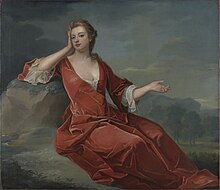This article has multiple issues. Please help improve it or discuss these issues on the talk page. (Learn how and when to remove these messages)
|
The Duchess of Marlborough | |
|---|---|
 | |
| Keeper of the Privy Purse | |
| In office 1702–1711 | |
| Monarch | Anne |
| Preceded by | Caspar Henning |
| Succeeded by | The Lady Masham |
| Personal details | |
| Born | Sarah Jenyns 5 June 1660 St Albans, Hertfordshire, Kingdom of England |
| Died | 18 October 1744 (aged 84) St James's, London, Kingdom of Great Britain |
| Resting place | Blenheim Palace |
| Spouse(s) | John Churchill, 1st Duke of Marlborough (m. 1677/78; d. 1722) |
| Children | 7, including: |
| Parent(s) | Richard Jennings Frances Thornhurst |
| Occupation | Mistress of the Robes to Queen Anne of Great Britain |
| Signature | |
Sarah Churchill, Duchess of Marlborough, Princess of Mindelheim, Countess of Nellenburg (née Jenyns, spelt Jennings in most modern references;[1] 5 June 1660 (Old Style) – 18 October 1744), was an English courtier who rose to be one of the most influential women of her time through her close relationship with Anne, Queen of Great Britain. The Duchess of Marlborough's relationship and influence with Anne were widely known, and leading public figures often turned their attentions to her, hoping for favour from Anne.
The Duchess enjoyed a "long and devoted" relationship with her husband of more than 40 years, the great general John Churchill, 1st Duke of Marlborough.[1] After Anne's father, King James II, was deposed during the Glorious Revolution, Sarah Churchill acted as Anne's agent, promoting her interests during the reigns of William III and Mary II. When Anne came to the throne after William's death in 1702, the Duke of Marlborough, together with Sidney Godolphin, 1st Earl of Godolphin, rose to head the government partly owing to his wife.
While the Duke of Marlborough was fighting the War of the Spanish Succession, the Duchess kept him informed of court intrigue and conveyed his requests and political advice to the Queen.[2] The Duchess campaigned tirelessly on behalf of the Whigs, while also devoting herself to building projects such as Blenheim Palace. A strong-willed woman, she strained her relationship with the Queen whenever they disagreed on political, court, or church appointments. After her final break with Anne in 1711, the Duke and Duchess were dismissed from court, and the Duchess no longer had any communication with Anne, who died in 1714. The Duchess later had famous disagreements with many important people, including her daughter Henrietta Godolphin, 2nd Duchess of Marlborough; the architect of Blenheim Palace, John Vanbrugh; Prime Minister Robert Walpole; King George II; and his wife, Queen Caroline. The money she inherited from the Marlborough trust left her one of the richest women in Europe.[1][3] She died in 1744, aged 84.